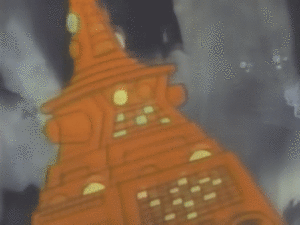Technical possibility, if appropriately misinterpreted, is also an opening for the spectral imagination. My new favourite piece of speculative “Halloween Tech” (that is, perhaps, technology specifically engineered to facilitate haunting) is the Computer Witch. I discovered the Computer Witch, appropriately enough, while randomly watching a low resolution internet upload of the 1977 cartoon Halloween special The Trouble with Miss Switch.
The Computer Witch has the ability to assess the quality of a person’s witchcraft. It is unclear whether the Computer Witch can itself cast spells. It is addressed as a sentient being, but also as something to fear, an alien thing. It is given a certain degree of reverence and awe from all the elder witches on the Witch Council. There doesn’t seem to be any specialists who execute tasks on or provide technical support for the Computer Witch. Instead it is addressed directly, and always referenced using the definite article, implying a unique, conscious entity and not a passive commercially available product. All of this suggests the Computer Witch is not simply a combination of hardware and software to be run. Perhaps the Computer Witch was once an actual Witch who has fused herself with or otherwise taken on the characteristics of a computer, like a magical cyborg or some kind of demonic technophiliac mimic. One thing is clear: the Computer Witch is considered “up to date” and contrasted with old fashioned witchcraft.
I assume the main advantage of the Computer Witch lies in its ability to analyze vast amounts of bigwitch data and make assessments, predictions and judgments on witchcraft related matters. It trains itself based on predictive modeling and grows more powerful over time, gorging itself instantaneously on uncountable variations and patterns accumulated from the entire documented history of magic and the occult. Like chess programs it is capable of making objectively stronger spells and predictions than analog witches. But it certainly comes with a degree of coldness and unaccountable logic that is perhaps in direct contradiction with the spirit of magic. Certainly it would be at a disadvantage to occulted, undocumented, symbolic and/or orally passed down lore, for which it would hunger, desperate for datafication and binary encoding of erstwhile ethereal traditions. Yet perhaps this apparent contradiction is the secret generative tension at the heart of Computer Witch’s abilities. When the need for radical contingency, tactile personal touches and/or mortal subjective limitations are required, the Computer Witch starts to overheat and malfunction. Yet this very potential for short-circuiting allows it to tap into even more obscure, unseen forces. Through its own limitations the Computer Witch has access to the dark and barely understandable world of Glitch Magic.
In the cartoon the Computer Witch is given a one-dimensional role as a foil to the more personable, wholesome, and frankly uninteresting humanist pedagogical witchcraft of Miss Switch. But I like to think that many of the more evil witches on the council saw the true potential of the Computer Witch. Perhaps the Computer Witch has its own devotional cult. Perhaps it has poetic heteronyms dedicated to its different aspects, like Algorithmis, Hecabyte, or The Unnamed Executable. Some of its acolytes were probably one dimensional technomancers with a naive faith in the development of artificial intelligence and machine learning. But perhaps others saw the true magical significance of Computer Witch in the gulf between the circuit board and the grimoire. Irreconcilable, the Computer Witch of 1977 perfectly predicted the haunted dawn of the anti-information age we find ourselves in 46 years later. In every sense of the word, it has a macabre “charm”, combining retro-futurist poetics of an emerging computer with a goofy Halloween spirit of cartoon slapstick and, in the end, a haunting accuracy on the feeling of the contemporary technomythos.
Possibilities of constructing a Home Computer Witch. A tentative recipe.
-
- A witch’s hat
- A familiar
- A devotee
- An altar
- Halloween decorations, pumpkins etc.
- Hauntological soundscape
- Computer parts, preferably dated, mismatched, damaged, unidentifiable
- Technical bric-a-brac
- Blood, organic matter, bones
- Sigils
- A pareidoliac face comprising buttons, lights, dials
- Magical power source
- Electricity
Jason Abdelhadi, October 30 2022.



